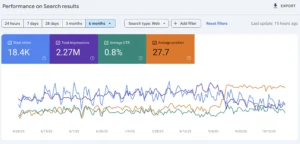
Complete Guide to Voice Search Optimization for Your Website
Voice search is no longer a novelty—it’s rapidly becoming an essential part of our digital world. With voice-enabled devices like smartphones, smart speakers, and digital assistants growing in popularity, businesses must adapt to this evolving trend to stay competitive. At FOG Digital Marketing, we help businesses optimize their websites for voice search and ensure they remain visible to their target audiences in an ever-changing digital landscape.
Understanding the Growing Importance of Voice Search
The Rise of Voice Search
Voice search has seen significant growth, and it’s projected that more than half of households will own a voice-enabled device. This surge demonstrates a shift in how people search online—opting for the convenience and speed of voice queries over typing. For businesses, this means adapting their SEO strategies to accommodate this new search behavior.
How Voice Search Differs from Traditional Search
Traditional typed search queries are typically short and direct, like “best Italian restaurant near me.” Voice search, on the other hand, is more conversational, reflecting natural speech. A voice query might sound like, “Hey Google, what’s the best Italian restaurant nearby that’s open right now?” This change requires businesses to rethink their approach to SEO, focusing more on long-tail and conversational keywords.
Adopting a Conversational Approach
Given the conversational nature of voice search, it’s crucial to adapt your content accordingly. Using conversational language helps make your website more relatable and user-friendly, ultimately catering to voice search users. At FOG Digital Marketing, we emphasize the importance of crafting content that speaks directly to users in a natural and approachable way.
Understanding Your Audience’s Behavior
Before diving into content optimization, it’s important to understand your target audience and their behavior. Are they asking specific questions? Are they using voice search primarily on mobile devices or smart speakers? Gathering real-time data about your audience will help you craft a more effective voice search optimization strategy.
Key Takeaway: Optimizing for voice search involves understanding how users speak, their intent, and their preferred devices. With partners like FOG Digital Marketing, businesses can make this transition seamlessly, ensuring they stay competitive in the voice-first world.
Actionable Strategies for Voice Search Optimization
To succeed in the voice search space, businesses need to take proactive and strategic steps. Here are several actionable strategies to make your website voice search-friendly and stand out from the competition.
1. Strengthen Local SEO for Voice Search
Many voice searches are location-based, so optimizing for local SEO is crucial. Queries like “Where can I get website maintenance near me?” are common in voice searches. By focusing on local SEO, your business can be the answer to these queries.
Ensure NAP Consistency: Make sure your business’s Name, Address, and Phone number (NAP) are consistent across all platforms, including your website, social media, and local directories. Consistency builds trust with search engines and improves your chances of ranking in local voice searches.
Leverage Google My Business: Claiming and optimizing your Google My Business (GMB) listing is a key step. Include accurate business details, gather reviews, and update your operating hours to help voice search users find the most relevant information about your business.
2. Use Long-Tail and Question-Based Keywords
Voice search queries tend to be more specific than typed ones. Instead of focusing solely on short, competitive keywords, incorporate long-tail keywords that reflect natural, detailed questions.
- Incorporate Questions into Your Content: Use tools like “Answer the Public” to identify common questions in your industry. Incorporate these questions into your content to make it more relevant for voice search users. For instance, if you offer website maintenance, a blog post titled “How often should I update my website?” can be very effective.
3. Target Featured Snippets
Voice search devices often pull answers from featured snippets at the top of Google’s search results. To increase your chances of being featured:
- Structure your content with clear headings and concise answers.
- Use bullet points or numbered lists for easy readability.
- Target specific questions that align with common voice queries.
Using Schema Markup for Voice Search Optimization
Schema markup is a technical tool that helps search engines understand the content on your website. Even if your content is high-quality, search engines may struggle to interpret its context without structured data.
What Is Schema Markup?
Schema markup is a semantic code added to your website that provides additional context to search engines. For example, if you mention an event, using schema helps search engines understand the details, such as date and location, which can then be displayed prominently in search results.
Boosting Voice Search Potential with Schema
Adding schema markup enhances the chances of your content being picked up by voice search. If a user asks their voice-enabled device about “best practices in logo design,” and your page on logo design is optimized with schema, it stands a higher chance of being selected as the answer.
Advanced Techniques to Stay Ahead in Voice Search
As voice search continues to evolve, staying ahead requires the adoption of advanced tools and techniques that can give you a competitive edge.
1. Embrace AI for Voice Search Optimization
The use of Artificial Intelligence (AI) in voice search optimization offers unique advantages:
AI-Powered Content Creation and Optimization: Tools like Jasper.ai and ChatGPT can help create conversational, long-tail content tailored for voice search users. Businesses that partner with firms like FOG Digital Marketing can leverage these tools to improve their content strategy.
Predictive Analysis for Content Strategy: AI tools can analyze user data to forecast trends, helping you create content that addresses future voice search queries.
2. Ensure Your Website Is Mobile-Friendly
A significant portion of voice searches happens on mobile devices, making mobile optimization a priority.
- Responsive Design and Speed: Ensure your website loads quickly and looks good on all devices. A slow or poorly designed mobile site can hinder your voice search optimization efforts. Utilize professional website maintenance services to keep your site optimized.
3. Integrate Voice Search Features on Your Website
Consider integrating voice search functionality directly onto your website. This allows users to interact with your content using voice commands, which enhances the user experience and positions your brand as voice search-friendly.
Preparing for a Voice-First Future
The importance of voice search is only set to grow, and businesses need to adapt to this shift. By implementing the strategies discussed in this guide, your website can be better prepared for a voice-first future.
Remember, the goal is not just to optimize for voice search but to provide genuine value to your audience. Align your content strategy with your audience’s interests and needs, and follow Google’s E-A-T (Expertise, Authoritativeness, Trustworthiness) guidelines to ensure sustainable success. Prioritizing high-quality content and user-centric optimization will help your business stay competitive as voice search continues to evolve.
Final Thoughts
We hope this guide provides you with valuable insights on how to optimize your website for voice search. As the digital landscape continues to change, FOG Digital Marketing is here to guide businesses through every step, ensuring they stay at the forefront of innovation.
Ready to optimize your website for voice search?
Contact us today and let’s ensure your business is ready for a voice-first future.




